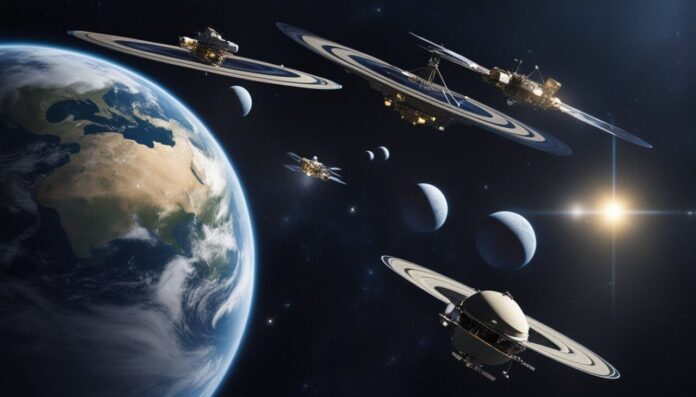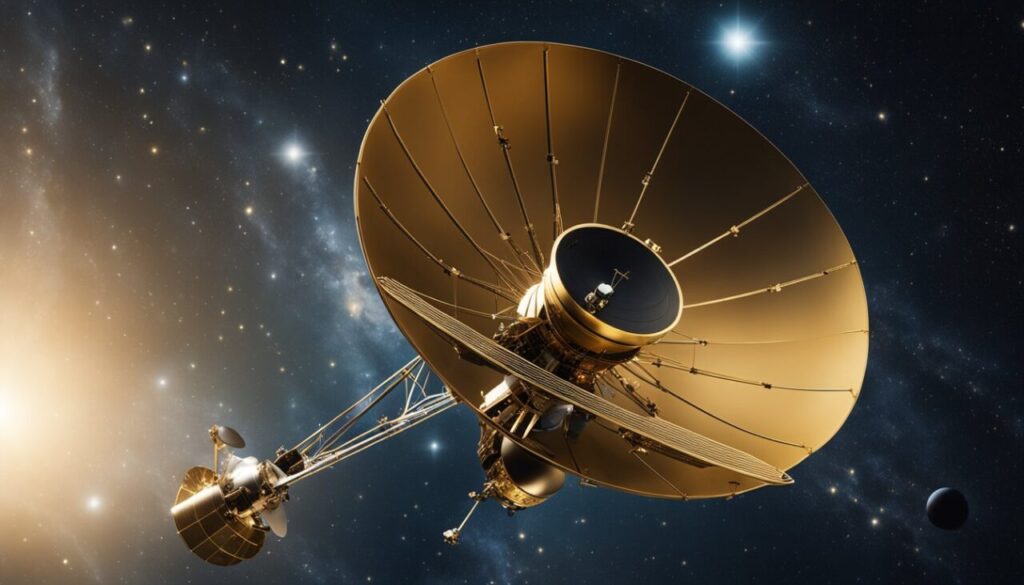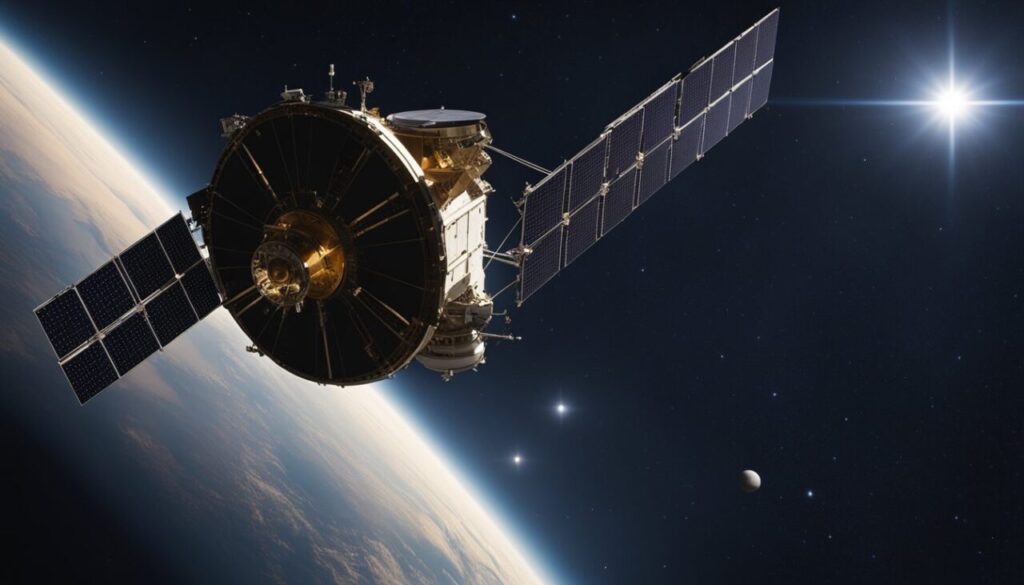
As technology advances, so does mankind’s ability to explore the never-ending universe. In the past few decades, several spacecraft (artificial or man-made objects) have been launched into space, each with a specific mission to explore different parts of our solar system and beyond.
Some of these spacecraft have traveled the farthest, going beyond our solar system and into interstellar space.
In this article, we will discuss the top 5 most distant man-made objects in space.
So, without further ado – let’s begin.
Voyager 1: The Farthest Spacecraft

The first spacecraft on our list is Voyager 1. Launched in 1977, Voyager 1 was designed to study the outer planets of our solar system. It completed its mission in 1980 and has been traveling towards interstellar space ever since.
As of January 2024, Voyager 1 is approximately 15.2 billion miles (24.4 billion km) away from Earth, making it the most distant spacecraft ever built by humans.
Voyager 1 is equipped with a variety of scientific instruments, including cameras, spectrometers, and magnetometers, which have allowed scientists to learn more about the outer planets and their moons.
Voyager 1 space probe made several great discoveries throughout its journey.
Some of the most interesting findings include:
- Evidence of the Heliopause: Voyager 1 discovered the first direct evidence of the heliopause, marking the boundary where the influence of our Sun ends and interstellar space begins.
- Moons: Voyager 1’s discoveries extended beyond planets to moons like Titan, Io, and Enceladus. These moons revealed diverse features such as liquid water, hydrocarbon landscapes, and volcanic activity.
- Plasma “Hum” in Interstellar Space: Voyager 1 detected a faint plasma “hum” in interstellar space. “Plasma hum” is a low-frequency humming sound emitted by plasma in space. Plasma is the fourth state of matter, consisting of ionized gas with both positive and negative particles. In certain space environments, such as near planets or within the interstellar medium, plasma can produce a distinct humming noise due to interactions with magnetic fields and other particles.
And while it still continues to transmit data to Earth, Voyager 1 has deactivated most of its instruments, with the spacecraft anticipated to become completely inactive by 2025 or latest 2030.
Interesting fact: Voyager 1 carries a golden record (vinyl) that contains sounds and images representing Earth's culture and life, in case it is ever found by extraterrestrial life forms.
Voyager 2: Exploring Beyond the Planets
Launched on August 20, 1977, Voyager 2 is one of NASA’s most successful missions. It is the only spacecraft to have visited all four giant outer planets in our solar system: Jupiter, Saturn, Uranus, and Neptune.
After completing its primary mission, Voyager 2 continued to explore beyond the planets and is currently the second most distant spacecraft from Earth, after Voyager 1.
Voyager 2 is equipped with a wide range of scientific instruments that allow it to study the environment and characteristics of the planets it visited. It discovered several new moons and provided valuable data on the planets’ atmospheres, magnetic fields, and rings.
Despite being 12.6 billion miles (20.3 billion km) away from Earth, Voyager 2 is still communicating with NASA’s Deep Space Network. It takes about 18 hours for a signal to travel from Earth to Voyager 2, and another 18 hours for a response to be received. However, the signal is now very weak and unreliable in providing comprehensive data.
Interesting fact: Voyager 2 was actually launched 16 days before his twin Voyager 1.
Pioneer 10: The First to Leave the Inner Solar System
Launched on March 2, 1972, Pioneer 10 was the first spacecraft to travel through the asteroid belt and leave the inner solar system. The spacecraft was designed to conduct scientific experiments and study Jupiter’s atmosphere, magnetic field, and radiation belts.
Pioneer 10 completed its mission successfully and continued to transmit data until its last signal was received on January 23, 2003.
At the time, it was over 12 billion kilometers away from Earth.
Currently, Pioneer 10 is in the constellation of Taurus, at a distance of 20.25 billion kilometers from Earth.
Interesting fact: Pioneer 10 was the first spacecraft to carry a plaque to communicate with extraterrestrial life. The plaque depicted a man and a woman, a map of the solar system, and other symbols that could be interpreted by intelligent life.
Pioneer 11: Following in Giant Leaps

Pioneer 11 is a spacecraft that was launched in 1973 with the aim of exploring the outer solar system. It is one of the most distant man-made objects from Earth, currently located in the constellation of Scutum, approximately 16.8 billion kilometers away from the Earth. Pioneer 11’s mission was to study the gas giants Jupiter and Saturn, their moons, and the interplanetary medium.
The spacecraft was equipped with a variety of scientific instruments, including a magnetometer, a cosmic ray detector, and a plasma analyzer. It also carried a camera that took images of Jupiter and its moons, as well as Saturn and its rings.
Pioneer 11 made history by being the first spacecraft to fly by Jupiter and Saturn.
After completing its mission, Pioneer 11 continued to travel through space, becoming the first man-made object to cross the asteroid belt and reach the outer solar system.
Interesting fact: On September 1, 1979, Pioneer 11 made history by becoming the first earthly craft to sweep past Saturn.
New Horizons: Journey to Pluto and Beyond
Launched in 2006, New Horizons is a NASA spacecraft that has been on a journey to explore the outer reaches of our solar system. Its primary mission was to study Pluto, and it accomplished this goal in 2015, providing us with the first-ever close-up images of the dwarf planet.
After its successful mission to Pluto, New Horizons continued its journey into the Kuiper Belt, a region beyond Neptune that is filled with icy objects. In 2019, it flew by a small object called Ultima Thule, which is located over 4 billion miles away from Earth.
New Horizons is currently on an extended mission to study the Kuiper Belt and the objects within it.
It is expected to continue transmitting data back to Earth until the late 2030s.
The distance of New Horizons from Earth is currently 8,8 billion kilometers.
Interesting fact: New Horizons' journey to Pluto took almost a decade, and it traveled over 3 billion miles to reach its destination.
Conclusion

In conclusion, the top 5 most distant spacecraft in space are truly amazing achievements of human engineering and exploration. These spacecraft have traveled gigantic distances and have provided priceless insights into our solar system and beyond.
Each of these spacecraft has contributed massively to our understanding of the universe and will continue to do so for many years to come.
And who knows, perhaps soon, some alien will find the golden vinyl and listen to Mozart, Bach, Beethoven, Stravinsky, and other great composers included in the record.




























